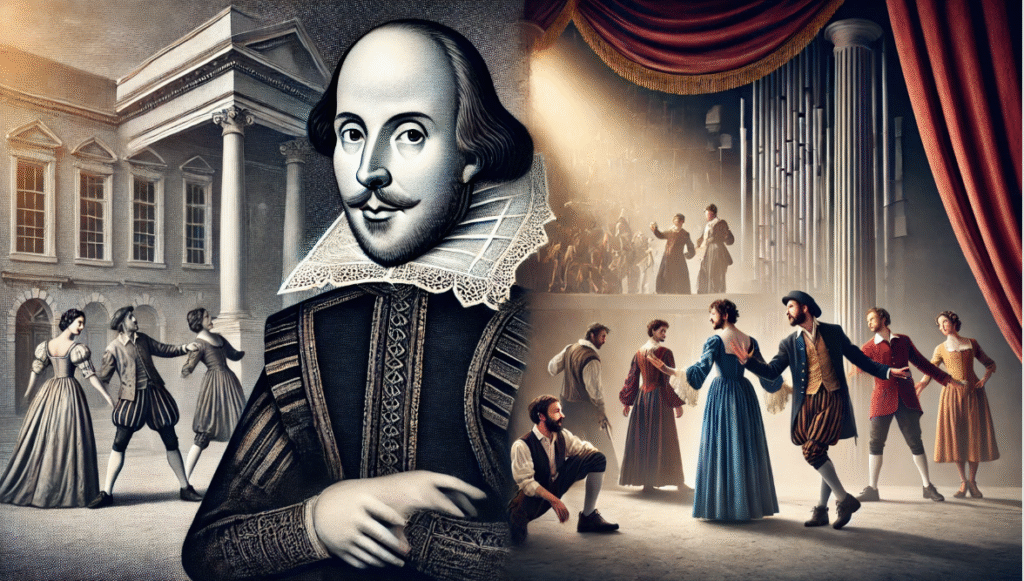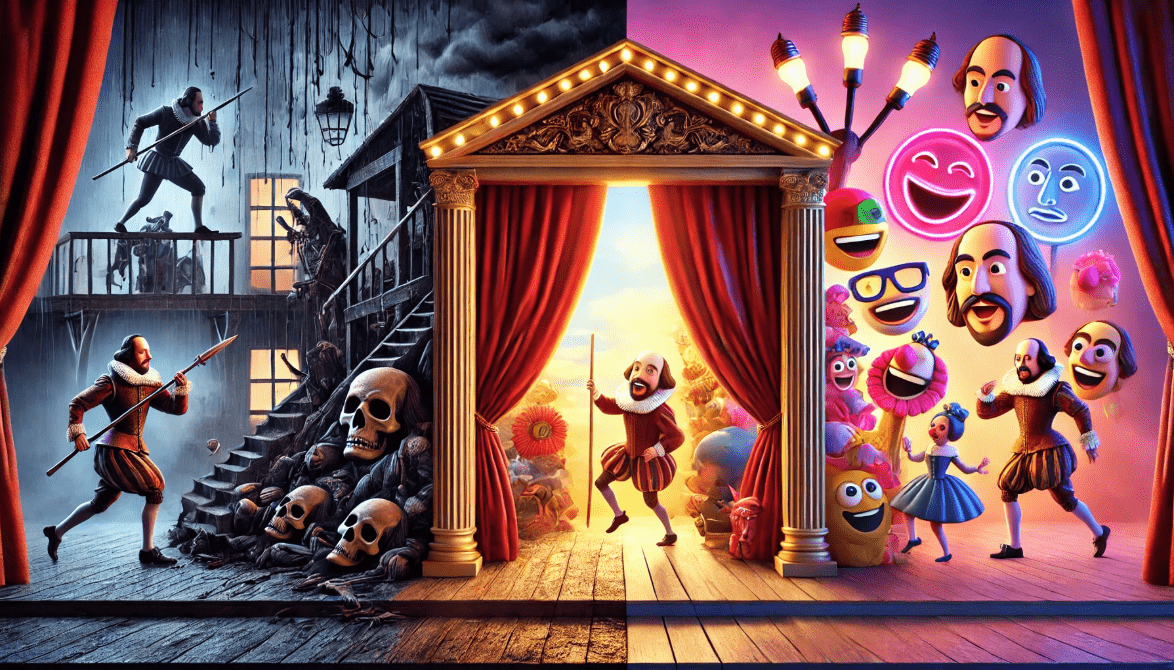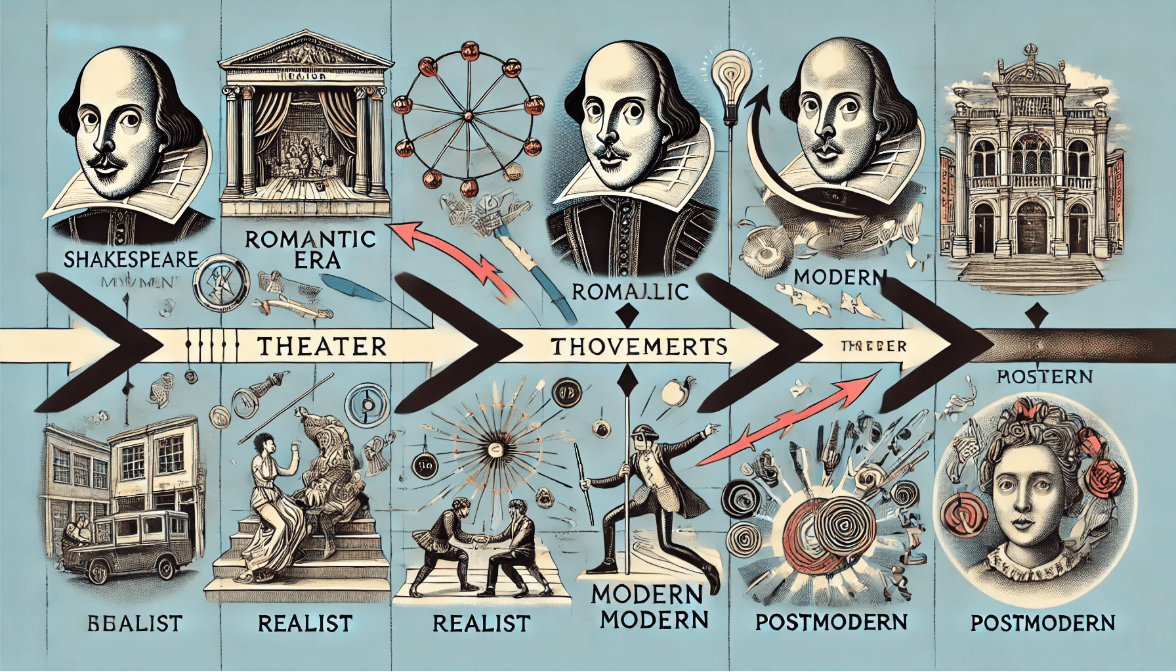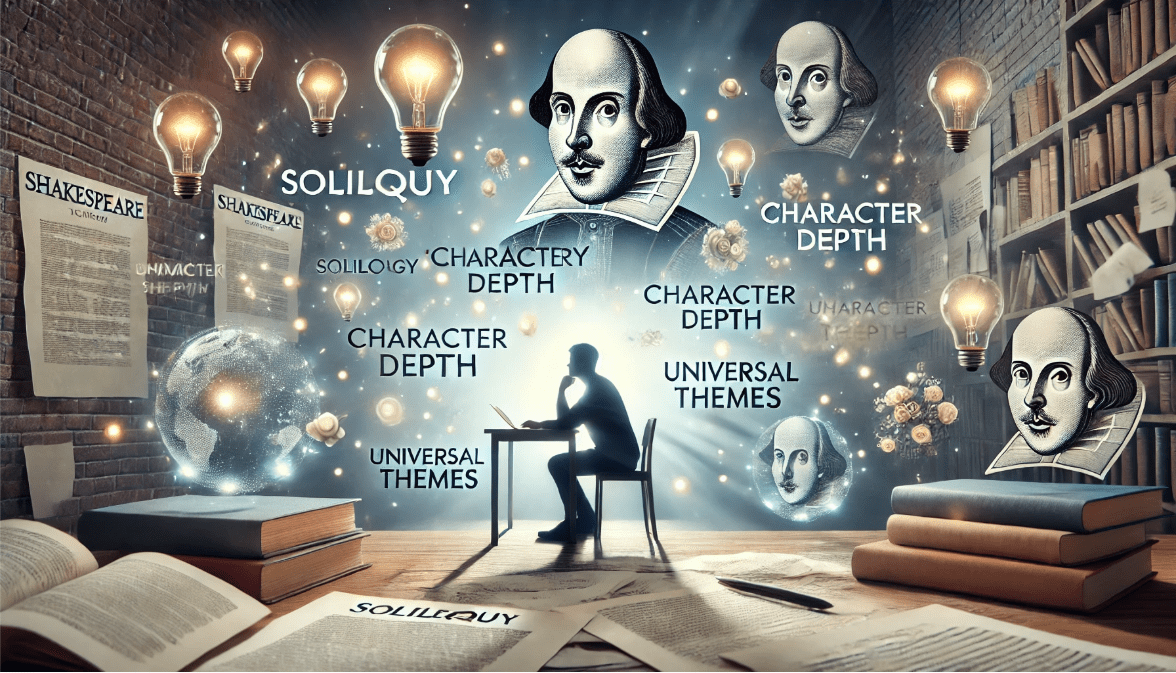
Understanding the Influence of Shakespeare on Playwriting Traditions: How His Legacy Shaped Modern Theater
When we think of iconic playwrights, William Shakespeare immediately comes to mind. His work, written over 400 years ago, continues to shape how stories are told on stage today. But have you ever wondered how the influence of Shakespeare on playwriting traditions is still felt in modern theater?
Whether you’re a budding playwright, a theater enthusiast, or simply curious about the evolution of storytelling, understanding how Shakespeare’s innovations have shaped contemporary playwriting can provide valuable insights. From character development to plot structure, Shakespeare revolutionized the way we create and consume drama. In this article, we’ll explore how his techniques have endured through the ages and how they can still inform your creative journey. Let’s dive in!
Table of Contents
Toggle1. Who Was William Shakespeare? A Quick Overview

William Shakespeare is often hailed as the greatest playwright in history. Born in 1564 in Stratford-upon-Avon, England, he wrote 39 plays, 154 sonnets, and several poems that continue to captivate audiences worldwide. His works are known for their timeless themes, complex characters, and beautiful language—making them relevant even in today’s fast-paced, modern world.
Shakespeare’s plays cover a range of genres, from tragedy and comedy to history and romance. Some of his most famous works, like Hamlet, Romeo and Juliet, and Macbeth, explore human emotions and dilemmas that are just as relatable now as they were in the 16th century.
His impact on modern theater is immense. By blending intense emotions with intricate plots, Shakespeare not only revolutionized storytelling but also created a framework that modern playwrights still use today. Whether through character development, thematic depth, or dialogue, his influence can be seen across almost every form of theater.
2.Shakespeare’s Playwriting Techniques That Transformed Theater
Shakespeare didn’t just write plays—he revolutionized the art of storytelling on stage. His unique playwriting techniques are still deeply embedded in modern theater. Let’s explore the key elements that made his works stand out and how they continue to influence playwrights today.
1. Complex Characters
Shakespeare was a master at creating characters that felt real, flawed, and multi-dimensional. Unlike earlier playwrights who often wrote more one-dimensional characters, Shakespeare’s heroes and villains alike had rich inner lives. Think of Hamlet, torn by indecision, or Lady Macbeth, driven by ambition. These characters wrestle with their desires, fears, and regrets, making them relatable to modern audiences.
Actionable Tip: To make your characters more engaging, give them internal conflicts, moral dilemmas, and personal growth arcs, just as Shakespeare did.
2. The Power of Soliloquies
One of Shakespeare’s most famous techniques is the use of soliloquies—long speeches where characters express their innermost thoughts. This device allows the audience to hear what the character is truly thinking, creating a deeper emotional connection. Who can forget Hamlet’s iconic “To be or not to be”? It’s a perfect example of how a soliloquy can explore complex themes like life, death, and purpose.
Actionable Tip: Consider adding soliloquies to your plays to give characters an opportunity to reveal their deepest feelings and thoughts to the audience.
3. Blending Tragedy, Comedy, and History
Shakespeare didn’t confine himself to a single genre. He skillfully blended tragedy, comedy, and history within his works, giving his audiences a variety of emotions and experiences. Plays like The Merchant of Venice mix humor with dark themes, while King Lear combines tragic depth with moments of dark irony. This genre blending keeps modern audiences on their toes, never quite knowing what emotional tone to expect.
Actionable Tip: Mix different genres in your writing to create unexpected emotional twists. Combining comedy and tragedy can deepen the impact of your work.
4. Mastery of Language and Wordplay

Shakespeare’s use of language was revolutionary. He invented words and phrases that we still use today, like “break the ice” or “wild-goose chase.” His creative use of metaphor, wordplay, and puns gave his characters a unique voice and made the dialogue sparkle with wit and intelligence.
Actionable Tip: Play with language in your writing. Don’t be afraid to invent new expressions or add clever wordplay to make your characters’ voices stand out.
5. Deep Exploration of Universal Themes
At the heart of many of Shakespeare’s works are universal themes—love, betrayal, power, ambition, and the human condition. These themes are timeless and resonate with audiences across cultures and eras. The emotional complexity of these themes makes Shakespeare’s works endlessly relevant.
Actionable Tip: Focus on universal themes in your plays. Tapping into timeless topics like love, fear, and ambition ensures your work will connect with a broad audience.
3. Shakespeare’s Influence on Modern Playwriting Traditions
Shakespeare’s impact on modern playwriting cannot be overstated. His innovative techniques, from character development to storytelling structures, continue to shape how playwrights craft their works today. Let’s dive into the lasting influence Shakespeare has had on contemporary theater.

1. Complex Characters and Deep Psychological Insight
One of the biggest shifts Shakespeare introduced was the creation of multi-dimensional characters. Before his time, characters were often flat, fulfilling specific roles without much complexity. Shakespeare changed that by giving his characters conflicting desires, fears, and flaws.
Modern Impact: This approach is seen everywhere today. Whether in Breaking Bad’s Walter White or in the antiheroes of House of Cards, characters now reflect the complexity Shakespeare pioneered. Playwrights use these layered personalities to explore themes of identity, morality, and transformation.
Actionable Tip: When writing your own characters, think beyond surface traits. Give them internal struggles and contradictions to make them more relatable and dynamic.
2. Blending Genres for Emotional Depth
Shakespeare was a master at blending tragedy, comedy, and history in ways that created powerful emotional shifts. In A Midsummer Night’s Dream, he mixed fantasy and comedy, while in Macbeth, he brought dark tragedy together with moments of supernatural horror. These genre fusions kept audiences engaged, never quite knowing what emotional tone to expect.
Modern Impact: Today, we see this same genre-blending in movies and plays. Works like The Book of Mormon combine humor with serious themes, while modern dramas often mix dark comedy with intense drama.
Actionable Tip: Don’t feel restricted by genre labels. Mix elements of comedy, tragedy, and fantasy to create more complex and unpredictable emotional experiences for your audience.
3. Thematic Universality and Cultural Relevance
Shakespeare’s ability to tackle universal themes—like love, jealousy, ambition, and revenge—meant that his works resonated with audiences of all cultures and time periods. Plays like Romeo and Juliet and Hamlet explore themes of power and fate that are still relevant in contemporary society.
Modern Impact: Today’s playwrights draw on these same themes. For instance, works like The Lion King (inspired by Hamlet) and The Crucible reflect themes of power struggles and moral dilemmas that are still prevalent in modern-day society.
Actionable Tip: Tap into timeless themes when writing your plays. Issues like love, betrayal, and ambition continue to speak to modern audiences, ensuring your work stays relevant across generations.
4. Complex Plot Structures and Non-linear Narratives
Shakespeare didn’t always follow a straightforward narrative structure. His plays often used multiple storylines that intersected, layered upon one another to create a richer, more engaging experience. In King Lear, for example, we see several subplots that mirror and heighten the main storyline.
Modern Impact: Modern playwrights and screenwriters have adopted this technique. Movies like Pulp Fiction and TV shows like Game of Thrones use non-linear storytelling, multiple plotlines, and interwoven narratives to keep the audience hooked.
Actionable Tip: Consider incorporating subplots or flashbacks into your work. These techniques can add depth to your story and keep your audience intrigued.
5. The Continued Use of Soliloquies and Monologues
The soliloquy is one of Shakespeare’s signature techniques, where characters speak their inner thoughts aloud, often in lengthy, reflective monologues. These speeches allow the audience to dive deep into a character’s psyche, making the emotional stakes of the story even more powerful.
Modern Impact: Soliloquies are still used today, not just in theater but also in film and TV. Movies like The Social Network and shows like Sherlock feature long monologues that help the audience understand a character’s motivations and inner conflict.
Actionable Tip: Try using monologues or reflective soliloquies in your writing to give your audience insight into your characters’ minds. This can make them feel more connected to the narrative.
4. Shakespeare’s Influence on Theater Genres: From Tragedy to Comedy
Shakespeare didn’t just define the forms of tragedy and comedy—he blended them, creating a range of emotional experiences that modern theater still embraces today. His influence on how we view and create both genres is immense. Let’s explore how Shakespeare shaped these genres and how his innovations continue to inspire playwrights in the present day.

1. Tragedy: More Than Just Sorrow
Before Shakespeare, tragedy often meant a story with a noble hero who fell due to fate or personal flaws. Shakespeare took this classic model and deepened it, introducing complex psychological layers to his tragic characters. For example, Macbeth isn’t just a man undone by ambition; he’s consumed by guilt and paranoia, making his downfall deeply emotional and relatable.
Modern Impact: Today’s tragic figures—whether in literature, film, or television—often share the same depth. Characters like Tony Soprano from The Sopranos or Walter White from Breaking Bad experience complex inner turmoil, echoing Shakespeare’s tragic heroes.
Actionable Tip: To write your own tragic characters, focus not just on their flaws, but on their emotional journey. What internal conflicts drive them to their downfall?
2. Comedy: Layered Humor and Wit
Shakespeare’s comedies weren’t just about making people laugh—they often explored deep human experiences like love, identity, and misunderstandings. In plays like A Midsummer Night’s Dream, the humor arises from characters’ emotional struggles and confusions. The comedic elements make the more serious themes—like unrequited love or mistaken identity—feel even more poignant.
Modern Impact: Contemporary comedies, whether in theater, sitcoms, or rom-com films, often blend humor with deeper emotional or social commentary. Think of The Office or Parks and Recreation, where comedic moments are grounded in real human dynamics.
Actionable Tip: Use humor to highlight emotional depth. In your writing, let characters’ personal struggles or societal conflicts form the basis of the comedy. It’s about finding the balance between fun and meaningful themes.
3. Tragicomedy: Shakespeare’s Brilliant Hybrid
One of Shakespeare’s major contributions was blending tragedy and comedy into a single work. His tragicomedies, such as The Winter’s Tale and The Merchant of Venice, mix dark and light elements, offering audiences a more complex emotional experience. These plays could make you laugh one moment and leave you feeling somber the next.
Modern Impact: The tragicomedy format is alive and well today, influencing everything from film to television. Movies like The Royal Tenenbaums or The Squid and the Whale showcase this genre blend, offering sharp humor alongside deep, often painful emotional moments.
Actionable Tip: Consider weaving humor and tragedy into a single narrative. It makes your story feel more dynamic and emotionally rich. This balance keeps the audience on their toes, never quite sure whether to laugh or cry.
4. History Plays: Bringing the Past to Life
Shakespeare also revolutionized historical drama. Plays like Richard III and Henry V blend historical events with compelling, human-centered stories. Rather than dry recitations of events, Shakespeare turned historical figures into characters full of ambition, betrayal, and internal conflict.
Modern Impact: Today’s historical dramas, such as Hamilton or The Crown, use Shakespeare’s approach of blending factual history with personal drama. These productions focus on the human side of history, making it more engaging for modern audiences.
Actionable Tip: When writing historical plays or stories, focus on the emotional and personal conflicts of your characters. Show how they are shaped by—or shape—history. History is more relatable when we see it through the eyes of real, flawed people.
5. The Role of Shakespeare in Shaping Modern Theater Movements
Shakespeare’s influence doesn’t stop at the playwriting techniques we’ve discussed. His works played a crucial role in shaping several major theater movements throughout history. These movements not only transformed how theater was written and performed but also how audiences engaged with it. Let’s explore how Shakespeare helped shape these movements and their impact on modern theater.
1. The Romantic Movement: Embracing Emotion and Individualism
In the late 18th and early 19th centuries, the Romantic Movement rejected the rigid structures of classical theater and embraced emotion, individualism, and the exploration of the human spirit. Shakespeare’s work, with its complex characters and exploration of intense emotions, was a key inspiration for Romantic playwrights.
Modern Impact: Playwrights like Goethe and Schiller were influenced by Shakespeare’s deep psychological insight and emotional complexity. Today, this influence can be seen in plays and films that focus on personal struggle, intense feelings, and individual expression.
Actionable Tip: When writing, focus on the emotional and personal experiences of your characters. Explore their inner worlds and allow their personal journeys to drive the narrative.
2. The Realist Movement: Bringing Authenticity to the Stage

The Realist Movement, which emerged in the mid-19th century, sought to depict everyday life and social issues with authenticity and truth. While Shakespeare’s plays often feature larger-than-life characters, his ability to delve into human nature paved the way for realism on stage.
Modern Impact: Playwrights like Anton Chekhov and Henrik Ibsen were influenced by Shakespeare’s exploration of human conflict and moral dilemmas. Today, many contemporary playwrights still use the realistic portrayal of characters and relationships, exploring societal issues and personal struggles.
Actionable Tip: To create more authentic characters, think about how their real-world struggles and desires shape their actions. Focus on everyday situations but give them emotional depth.
3. Modernism: Breaking Traditional Boundaries
Modernism, which gained momentum in the early 20th century, sought to break free from traditional structures and conventions in art and theater. Shakespeare’s willingness to experiment with language, structure, and genre influenced this radical shift. His works, with their non-linear plots and mix of genres, encouraged playwrights to explore more abstract and innovative forms of storytelling.
Modern Impact: In modern theater, you can see echoes of Shakespeare in experimental works and avant-garde productions. Playwrights and directors like Samuel Beckett and Tom Stoppard embraced unconventional structures, much like Shakespeare did, to challenge audiences and push the boundaries of theater.
Actionable Tip: Don’t be afraid to break the rules in your own writing. Experiment with unconventional formats, timelines, and narrative techniques to create unique and engaging stories.
4. Postmodernism: Playing with Metafiction and Self-Awareness
Postmodernism, which emerged in the mid-20th century, focused on self-awareness, irony, and deconstructing traditional narratives. Shakespeare’s ability to layer multiple meanings and create plays within plays (e.g., Hamlet and A Midsummer Night’s Dream) helped lay the groundwork for this movement.
Modern Impact: Today’s postmodern theater often features meta-theatrical elements, where characters are aware they are in a play, or the narrative itself is self-referential. Works like The Vagina Monologues or Noises Off play with the idea of the play within a play, a concept Shakespeare introduced centuries ago.
Actionable Tip: If you want to explore postmodern elements in your writing, try adding self-aware characters or create a “play within a play” dynamic. Let your audience reflect on the nature of storytelling itself.
6. How to Incorporate Shakespeare’s Techniques into Your Own Writing
Shakespeare’s playwriting techniques have stood the test of time because they resonate with audiences on a deep emotional and intellectual level. Want to bring some of that timeless magic into your own writing? Here’s how you can incorporate his methods to enhance your stories and captivate modern audiences.
1. Create Complex, Multi-Dimensional Characters
Shakespeare’s characters are known for their complexity. From Hamlet to Macbeth, his characters were flawed, human, and full of contradictions. This depth is what makes them timeless.
Actionable Tip: When developing your characters, focus on their internal conflicts, moral dilemmas, and psychological depth. Ask yourself: What are their fears? What do they want most, and what’s stopping them from getting it? The more real and layered they are, the more your audience will connect with them.
2. Use Soliloquies to Explore Inner Thoughts
Shakespeare often used soliloquies to give the audience direct access to a character’s thoughts. This technique reveals the character’s motivations and emotions, creating a deeper connection with the audience.
Actionable Tip: Incorporate moments where your characters speak directly to the audience, revealing their thoughts and dilemmas. Don’t be afraid of long, reflective monologues if it serves the emotional depth of the character. Use this technique to let the audience in on what the character is really thinking—just like Hamlet’s “To be or not to be.”

3. Mix Tragedy and Comedy for Emotional Depth
Shakespeare often blended comedy and tragedy, which kept his works engaging and unpredictable. The tragic elements made the comic moments feel lighter, while the comedy balanced the heavier, emotional parts.
Actionable Tip: Try weaving humor into serious situations. A dark moment can be lightened by a moment of comic relief, or vice versa. This emotional rollercoaster adds layers to your play and keeps your audience on their toes. Think of The Merchant of Venice—a play with serious themes, yet moments of sharp wit and humor.
4. Focus on Universal Themes
One of Shakespeare’s greatest strengths was his ability to write about universal human themes: love, ambition, jealousy, betrayal, and the search for identity. These themes continue to resonate with audiences, no matter the time or place.
Actionable Tip: Don’t shy away from writing about big, universal themes. Focus on the core human experiences that transcend time, like love, power, or personal redemption. These themes make your work relevant and emotionally powerful, no matter the era.
5. Experiment with Genre and Structure
Shakespeare wasn’t afraid to play with the traditional genre boundaries. His tragic plays sometimes had comedic elements, while his comedies could have darker, more dramatic moments. He also used non-linear structures, flashbacks, and multiple interconnected plotlines to keep his stories fresh.
Actionable Tip: Don’t limit yourself to one genre or a strict structure. Experiment with mixing tragedy and comedy, or try using non-linear storytelling. A blend of genres or an unconventional narrative structure can make your work stand out.
6. Use Language Creatively
Shakespeare had an unmatched command of language. He invented words, used metaphors, and crafted poetic dialogue that continues to inspire writers today. His use of language gave his works a timeless quality.
Actionable Tip: Be bold with your language. Don’t be afraid to use metaphors, puns, or invent new phrases. Challenge yourself to create dialogue that has rhythm, beauty, and meaning. Play with words the way Shakespeare did, and give your characters a voice that feels unique and memorable.
7. Shakespeare’s Impact Beyond Theater: Film and TV Adaptations
Shakespeare’s influence doesn’t just end on the stage. His works have been adapted countless times in film and television, proving that his stories and themes are as relevant today as they were in the 16th century. Let’s explore how Shakespeare’s legacy continues to inspire modern storytelling in film and TV, and how you can draw from his techniques in your own writing.

1. Timeless Stories Reimagined for the Big Screen
Many of Shakespeare’s plays have been reimagined as films, proving that his themes of love, ambition, betrayal, and power still resonate across different mediums. Classic plays like Romeo and Juliet, Macbeth, and Hamlet have been adapted into countless films over the years, each with a unique spin that speaks to different cultures and time periods.
Modern Impact: Movies like Romeo + Juliet (1996), directed by Baz Luhrmann, placed the iconic love story in a modern setting, while The Lion King (1994) was inspired by Hamlet. These adaptations show how Shakespeare’s stories can be transformed to reflect modern issues while maintaining their emotional core.
Actionable Tip: When adapting Shakespeare’s work (or any classic story), think about how you can update the setting, context, or characters while staying true to the underlying themes. Don’t be afraid to reimagine the story for today’s audience.
2. Shakespeare’s Influence on TV Shows
Many TV shows borrow heavily from Shakespearean themes, character archetypes, and plot structures. Shows like Game of Thrones and House of Cards draw from Shakespearean concepts of power, betrayal, and family drama. In fact, Game of Thrones is often compared to Macbeth or King Lear for its ruthless power struggles and morally complex characters.
Modern Impact: TV writers often use Shakespearean plots or character dynamics to enhance the drama in their shows. The complexity of Shakespeare’s characters—like Hamlet’s indecision or Lady Macbeth’s ambition—can be seen in modern characters like Walter White from Breaking Bad or Frank Underwood from House of Cards.
Actionable Tip: When writing for TV or film, explore themes like power, revenge, and moral ambiguity. Complex characters caught in difficult decisions will keep your audience hooked, just as Shakespeare’s tragic figures continue to do.
3. Meta-Theatricality and Play-within-a-Play
One of Shakespeare’s most famous techniques is the “play within a play,” seen in works like Hamlet and A Midsummer Night’s Dream. This self-referential style, where characters in the play are aware they are acting, has been embraced by many filmmakers and TV writers.
Modern Impact: Films like The Truman Show and TV series like The Office use this technique by breaking the fourth wall and involving the audience in the narrative. These works make the audience reflect on the nature of storytelling itself, much like Shakespeare’s meta-theatrical moments did.
Actionable Tip: Try incorporating moments where characters are aware they are part of a story, or where the audience is invited to question the narrative. This technique adds depth and complexity to your work.
4. Shakespeare’s Language and Wordplay in Film & TV
Shakespeare’s mastery of language, from clever puns to rich metaphors, continues to influence dialogue in films and TV. Whether it’s the playful banter in Much Ado About Nothing or the heavy soliloquies in Hamlet, Shakespeare’s language brings an emotional and intellectual layer to his characters and themes.
Modern Impact: Writers like Aaron Sorkin (creator of The West Wing and The Social Network) are known for their fast-paced, witty dialogue that mirrors Shakespeare’s clever use of language. His influence is also seen in the poetic language of films like Deadpool and the sharp wordplay in Sherlock.
Actionable Tip: In your writing, experiment with dialogue that’s both intelligent and emotional. Use metaphor and wit to reveal character motivations and make your dialogue memorable.
Shakespeare’s influence extends far beyond the theater, leaving its mark on films, TV shows, and popular culture. From timeless stories reimagined on screen to the complex characters and themes found in today’s best dramas, Shakespeare’s work continues to shape modern storytelling. By incorporating his techniques—whether it’s exploring universal themes, playing with language, or adapting classic stories—you can create work that resonates with audiences, just as Shakespeare’s plays continue to do.
William Shakespeare’s influence on playwriting traditions is undeniable, and his legacy continues to shape the world of theater today. From complex, multi-dimensional characters to innovative plot structures and unforgettable language, Shakespeare redefined storytelling in a way that resonates through the ages. Whether on stage, in film, or on television, his themes of love, betrayal, ambition, and the human condition remain just as powerful and relevant in modern storytelling.
As you embark on your own creative journey, remember that Shakespeare’s techniques are not just historical curiosities—they are tools that can elevate your writing, deepen your characters, and expand your narrative possibilities. By embracing his innovations, you can create stories that speak to audiences today, just as his works have spoken to audiences for centuries.
Shakespeare’s impact is timeless. So, whether you’re penning a play, writing for film, or developing a TV series, consider how his techniques can enrich your own work. With his legacy as your guide, you have the opportunity to create something that resonates just as deeply with modern audiences as Shakespeare’s masterpieces continue to do.
Frequently Asked Questions (FAQs)
1. How did Shakespeare influence modern playwriting?
Shakespeare revolutionized playwriting by creating complex characters, blending genres, and exploring universal themes like love, power, and ambition. His use of soliloquies, intricate plots, and rich language continues to influence modern playwrights and storytellers across various media. His techniques set the foundation for many storytelling conventions we use today.
2. What makes Shakespeare’s characters so influential?
Shakespeare’s characters are multi-dimensional, with flaws, contradictions, and emotional depth. They experience inner conflicts and moral dilemmas, making them relatable and timeless. Modern writers continue to create characters with similar complexity, inspired by Shakespeare’s ability to explore the human condition.
3. How can I incorporate Shakespeare’s techniques into my own writing?
To use Shakespeare’s techniques, focus on developing complex characters with internal struggles, experiment with mixing genres (e.g., comedy and tragedy), and use soliloquies to reveal a character’s inner thoughts. Also, explore universal themes like love and power to make your work resonate with a wide audience.
4. Why is Shakespeare still relevant in today’s theater?
Shakespeare’s exploration of timeless themes such as betrayal, ambition, and love keeps his works relevant. His innovative use of language and storytelling techniques also set the groundwork for modern plays, films, and TV series, making his influence continuous in contemporary storytelling.
5. How did Shakespeare impact theater genres?
Shakespeare transformed theater by blending tragedy, comedy, and history, creating more dynamic and emotionally layered narratives. His tragicomedies, where serious and light elements coexist, and his historical plays that humanized past figures, continue to inspire modern playwrights to break traditional genre boundaries.
6. What modern TV shows and films are influenced by Shakespeare?
Modern shows like Game of Thrones and House of Cards, and films like The Lion King and Romeo + Juliet, draw heavily from Shakespeare’s themes, characters, and plots. These adaptations keep his legacy alive, reinterpreting his works to reflect contemporary issues while retaining their emotional depth.
7. What role did Shakespeare play in shaping modern drama movements?
Shakespeare influenced major theater movements such as Romanticism, Realism, and Modernism. His emotional complexity inspired Romantic writers, while his exploration of human nature paved the way for Realism. His innovation in narrative structure and form also influenced the non-traditional storytelling of Modernism.
8. Can Shakespeare’s influence be seen outside of traditional theater?
Absolutely! Shakespeare’s impact extends beyond theater into film, television, and even literature. His stories and themes have been adapted into countless movies, TV series, and novels, showing how his influence transcends the stage and continues to shape popular culture today.





















